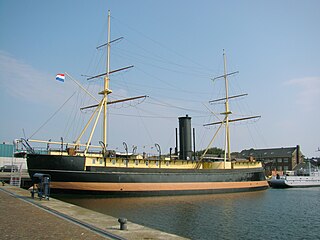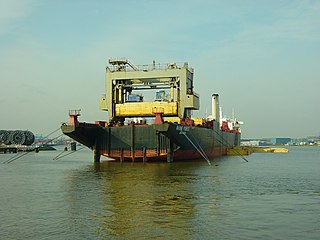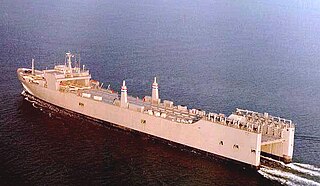
Barge nowadays generally refers to a flat-bottomed inland waterway vessel which does not have its own means of mechanical propulsion. The first modern barges were pulled by tugs, but nowadays most are pushed by pusher boats, or other vessels. The term barge has a rich history, and therefore there are many other types of barges.

A dry dock is a narrow basin or vessel that can be flooded to allow a load to be floated in, then drained to allow that load to come to rest on a dry platform. Dry docks are used for the construction, maintenance, and repair of ships, boats, and other watercraft.

A pusher, pusher craft, pusher boat, pusher tug, or towboat, is a boat designed for pushing barges or car floats. In the United States, the industries that use these vessels refer to them as towboats. These vessels are characterized by a square bow, a shallow draft, and typically have knees, which are large plates mounted to the bow for pushing barges of various heights. These boats usually operate on rivers and inland waterways. Multiple barges lashed together, or a boat and any barges lashed to it, are referred to as a "tow" and can have dozens of barges. Many of these vessels, especially the long distances, or long haul boats, include living quarters for the crew.
A lighter is a type of flat-bottomed barge used to transfer goods and passengers to and from moored ships. Lighters were traditionally unpowered and were moved and steered using long oars called "sweeps" and the motive power of water currents. They were operated by skilled workers called lightermen and were a characteristic sight in London's docks until about the 1960s, when technological changes made this form of lightering largely redundant. Unpowered lighters continue to be moved by powered tugs, however, and lighters may also now themselves be powered. The term is also used in the Lighter Aboard Ship (LASH) system.

HNLMS Schorpioen is a Schorpioen-class monitor built in France for the Royal Netherlands Navy in the 1860s. These new ships were equipped with heavy rifled 23 cm (9 in) guns, and a heavy armor. The hull had an armor plated belt of 15 cm (6 in) and the gun turret, housing the two guns, had almost 30 cm (12 in) of armor.

M/V Rochdale One was a cruise ship built by the French shipyard Ateliers et Chantiers Dubigeon-Normandie at Nantes in 1977 for the Soviet Union. As the Ayvasovskiy she was operated by the Danube Shipping Company, mainly in the Black Sea and the Mediterranean. At around 7,600 GRT, with a length of 121.5 metres (399 ft) and a draught of 4.5 metres (15 ft), she was small for a cruise ship and carried only 328 passengers.

The lighter aboard ship (LASH) system refers to the practice of loading barges (lighters) aboard a bigger vessel for transport. It was developed in response to a need to transport lighters, a type of unpowered barge, between inland waterways separated by open seas. Lighters are typically towed or pushed around harbors, canals or rivers and cannot be relocated under their own power. The carrier ships are known variously as LASH carriers, barge carriers, kangaroo ships or lighter transport ships.
Seaspan ULC provides marine-related services to the Pacific Northwest. Within the Group are three shipyards, an intermodal ferry and car float business, along with a tug and barge transportation company that serves both domestic and international markets. Seaspan, is part of the Washington Companies that are owned by Dennis Washington. Kyle Washington, is the Executive Chairman of Seaspan, who has become a Canadian citizen.

John H Amos is a paddlewheel tugboat built in Scotland in 1931. The last paddlewheel tug built for private owners, now owned by the Medway Maritime Trust. She is one of only two surviving British-built paddle tugs, the other being Eppleton Hall preserved at the San Francisco Maritime National Historical Park in San Francisco, California.

Thomas Hebert was an ocean-going tugboat that sank off the coast of New Jersey on Sunday 7 March 1993.

Mayflower is a steam tug built in Bristol in 1861 and now preserved by Bristol Museums Galleries & Archives. She is based in Bristol Harbour at M Shed. She is the oldest Bristol-built ship afloat, and is believed to be the oldest surviving tug in the world.

A péniche is a steel motorised inland waterway barge of up to 350 tonnes' capacity. Péniche barges were built to fit the post-1880s French waterways and the locks of Freycinet gauge. They are visually similar to a Dutch barge, but built to different specifications.
Numerous interpretations of Noah's Ark have been built and proposed. Some were intended to be replicas, as close as possible to the Biblical Ark, the builders assuming that such a boat did exist and that it is not a mythological vessel. Others are looser derivatives which were inspired by the idea. The Biblical description of the Ark is brief, beyond the basic measures of length, height and width, and the exact design of any "replica" must largely be a matter of conjecture. Some interpret the Ark as simply a chest-like structure with rectangular sides; other reconstructions give it a rounded bow and stern.
MV Okanagan was a tugboat that operated on Okanagan Lake, Penticton, British Columbia, from 1947 to 1972. It was the largest and last Canadian Pacific-operated tugboat on Okanagan Lake and its retirement marked the end of Canadian Pacific’s service on B.C.’s inland lakes and rivers, as well as 80 years of service on Okanagan Lake. During service, the Okanagan pushed railway barges up and down the lake and broke ice during winter.

SB Centaur is a wooden Thames sailing barge, built in Harwich, Essex, England in 1895. She was used to carry various cargoes, mainly grain, for the next 60 years. During the First World War she carried food and coal to the French Channel ports. During the Second World War Centaur was damaged when sailing to assist with the Dunkirk Evacuation. She did war work for the duration of the conflict.
Huibers is a Dutch patronymic surname. Huibert is a regional form of the given name Hubert. Among variant forms are Huiberts, Huijbers and Huybers. Notable people with the surname include:

The MV Oliver Cromwell was a Mississippi-style riverboat which was constructed as a Dutch barge in 1922 and converted into a riverboat hotel in 1993. As a stern Paddle steamer and served as a hotel, restaurant and cabaret venue in Gloucester Docks, Gloucester. The vessel sank in the Irish sea about 12 miles west of South Stack, Anglesey on 25 March 2018 whilst being towed to a new location in Coleraine, Northern Ireland.

PD-50, Soviet designation Project 7454, was a Russian large floating dry dock built at the Götaverken Arendal shipyard in Gothenburg, Sweden and commissioned in the 1980s. At the time, it was the world's largest floating dry dock and used primarily to service the ships and submarines of the Northern Fleet.

Type C8-class ships are a type of Heavy Lift Barge Carrier. Type C8 ships were the 8th type of ship designed by the United States Maritime Commission (MARCOM) in the late 1960s. As done with the Type C1 ships and Type C2 ships, MARCOM circulated preliminary plans for comment. The design presented was not specific to any service or trade route. Type C8 ships measuring 876 feet (267 m) from stem to stern, and designed to make 16.2 knots.

The oldest Rhine shipping company for bulk goods W. van Driel Stoomboot- & Transportbedrijven was founded in 1888 by Willem van Driel sr. (1845-1911), with headquarters on the Noordereiland in Rotterdam on the Maaskade to operate a tugboat company and to focus on mass transport to the Rhine of grain, ore, etc.


















